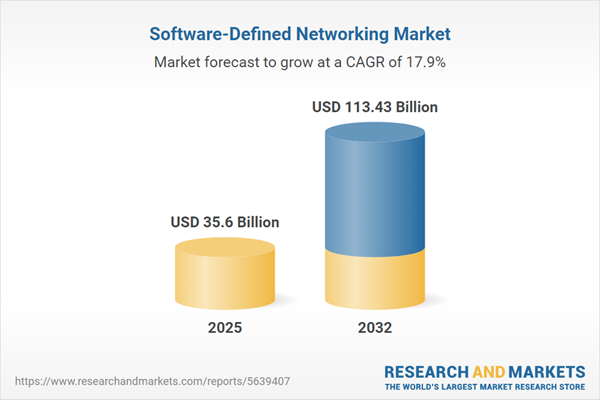Speak directly to the analyst to clarify any post sales queries you may have.
Software-Defined Networking is reshaping how enterprises manage complex network environments, driving more agility, operational efficiency, and security. As organizations navigate technology modernization and evolving business needs, a strategic approach to SDN adoption positions them to meet digital transformation goals and enhance network performance.
Market Snapshot: Software-Defined Networking Market Size and Growth
The Software-Defined Networking (SDN) market experienced robust expansion, growing from USD 30.37 billion in 2024 to USD 35.60 billion in 2025. The sector is projected to maintain strong momentum with a 17.90% CAGR, ultimately reaching USD 113.43 billion by 2032. This persistent growth underscores rising demand for flexible, programmable networks as organizations shift toward cloud models, edge computing, and IoT-driven architectures.
Scope & Segmentation
This comprehensive SDN market report offers detailed segmentation for targeted analysis and actionable insights:
- Components: Managed Services, Professional Services, SDN Analytics Solutions, SDN Applications, SDN Controllers, SDN Security Solutions, SDN Switches & Routers
- Model Types: API SDN, Hybrid Model SDN, Open SDN, Overlay Model SDN
- Architectures: Centralized, Distributed
- Deployment Models: Cloud Based, On Premise
- Enterprise Sizes: Large Enterprises, Small & Medium Enterprises (SMEs)
- End-User Sectors: Banking, Financial Services, and Insurance; Education; Energy & Utilities; Government & Defense; Healthcare; Manufacturing; Retail; Telecommunications & IT
- Regions: Americas (including North America and Latin America), Europe, Middle East & Africa, Asia-Pacific
- Key Companies: Allied Telesis Holdings K.K, Arista Networks, Broadcom, CDW LLC, Ciena, Cisco Systems, Dell, Extreme Networks, F5, Fortinet, Fujitsu, Google (Alphabet), HP Enterprise, Huawei, Infosys, IBM, Juniper Networks, Kyndryl, Lenovo, Microsoft, NEC, NTT Corp, Nokia, NVIDIA, Oracle, Palo Alto Networks, Pica8, Ericsson, Wipro
Key Takeaways for Senior Decision-Makers
- Adopting Software-Defined Networking strengthens network agility, enabling rapid deployment of digital services and streamlined operations.
- Centralized orchestration and policy-driven controls help organizations manage diverse network environments efficiently, reducing manual intervention and operational risks.
- Integration of SDN with security frameworks, such as zero trust and automated threat detection, elevates compliance and data protection capabilities across sectors.
- Hybrid cloud and on-premise models support gradual modernization for legacy infrastructure, reducing transition risks and investment shocks.
- Industry collaborations accelerate open standards adoption, helping enterprises avoid vendor lock-in and promote interoperability across multi-vendor ecosystems.
- Regional differences in digital infrastructure maturity and regulatory requirements drive tailored strategies for SDN deployment and value realization.
Tariff Impact on SDN Supply Chains
Recent U.S. tariff adjustments on networking hardware are heightening supply chain uncertainty and increasing procurement costs for switches, routers, and security appliances. Organizations are mitigating these effects by rethinking sourcing strategies, prioritizing alternative suppliers or geographies, and considering domestic production partnerships. These developments are prompting investments in modular hardware, pay-as-you-go service models, and risk-based vendor assessments, forcing IT teams to focus on resilient procurement and strategic sourcing to maintain uninterrupted network innovation.
Methodology & Data Sources
This report employs a mixed-methods approach, integrating primary research from interviews and surveys of network architects, IT executives, and service providers, with secondary analysis of technical publications, regulatory documents, and vendor materials. Data triangulation and expert panel reviews ensure insights are credible and decision-ready.
Why This Report Matters
- Enables decision-makers to benchmark SDN strategies against industry peers and align technology investments with organizational objectives.
- Provides guidance for navigating regulatory shifts and tariff impacts, helping de-risk network transformation and procurement planning.
- Offers actionable insights to optimize digital infrastructure and secure competitive advantages in a rapidly evolving networking landscape.
Conclusion
This Software-Defined Networking market report empowers technology leaders to confidently evaluate opportunities, adapt to supply chain and policy developments, and advance secure, future-ready network architectures for sustained growth.
Additional Product Information:
- Purchase of this report includes 1 year online access with quarterly updates.
- This report can be updated on request. Please contact our Customer Experience team using the Ask a Question widget on our website.
Table of Contents
3. Executive Summary
4. Market Overview
7. Cumulative Impact of Artificial Intelligence 2025
Companies Mentioned
The companies profiled in this Software-Defined Networking market report include:- Allied Telesis Holdings K.K
- Arista Networks, Inc.
- Broadcom Inc.
- CDW LLC
- Ciena Corporation
- Cisco Systems, Inc.
- Dell Inc.
- Extreme Networks, Inc.
- F5, Inc.
- Fortinet, Inc.
- Fujitsu Limited
- Google LLC by Alphabet Inc.
- HEWLETT PACKARD ENTERPRISE COMPANY
- Huawei Technologies Co., Ltd.
- Infosys Limited
- International Business Machines Corporation
- Juniper Networks, Inc.
- Kyndryl Holdings, Inc.
- Lenovo Group Limited
- Microsoft Corporation
- NEC Corporation
- Nippon Telegraph and Telephone Corporation
- Nokia Corporation
- NVIDIA Corporation
- Oracle Corporation
- Palo Alto Networks, Inc.
- Pica8 Software Inc.
- Telefonaktiebolaget LM Ericsson
- Wipro Limited
Table Information
| Report Attribute | Details |
|---|---|
| No. of Pages | 196 |
| Published | November 2025 |
| Forecast Period | 2025 - 2032 |
| Estimated Market Value ( USD | $ 35.6 Billion |
| Forecasted Market Value ( USD | $ 113.43 Billion |
| Compound Annual Growth Rate | 17.9% |
| Regions Covered | Global |
| No. of Companies Mentioned | 30 |









